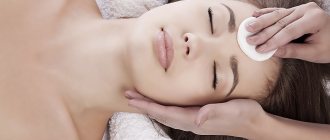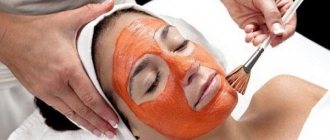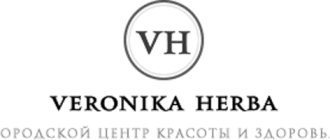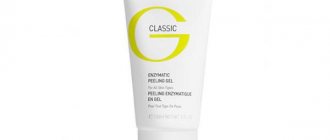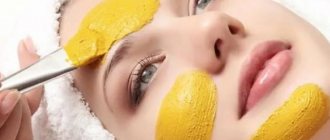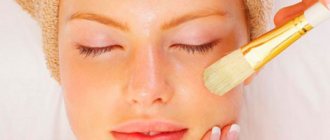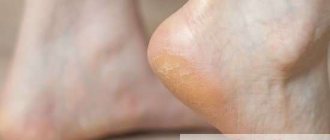In light of the fashionable trend towards non-invasive techniques, girls and boys increasingly prefer superficial peeling (the so-called “summer” or “all-season”) to take care of their skin.
Such procedures involve minimal or no peeling, as well as a comfortable feeling during treatment.
Superficial methods are good both as independent care and as preparation for deeper peels.
Those who have never had experience with peeling should definitely start with delicate measures. Only then move on to more radical ones.
Gentle procedures are good both in combination with other cosmetic procedures, and as an independent remedy.
Chemical peeling of the face: the achieved effect and indications for use
Chemical peeling
activates the body's protective functions, resulting in increased production of substances such as hyaluronic acid, collagen and elastin. This leads to improved skin tone, getting rid of unevenness, and smoothing out wrinkles. The procedure of chemical peeling of the face will also save you from skin pigmentation, including age-related skin, scars and marks left by acne.
Most often, chemical peeling of the facial skin is performed, but this method is often used to care for such parts of the body as the neck, hands, and décolleté.
Indications for chemical peeling
- Chemical peeling of the face is needed to combat age-related changes in the skin.
- Chemical peeling of the face is effective regardless of age and skin characteristics. The only difference will be the composition of the acids used and their concentration.
But you should not resort to chemical peeling in the fight against a number of age-related skin changes, which include loss of elasticity and sagging. In this case, chemical peeling will not work; it is better to resort to the services of plastic surgeons and get a facelift.
results
The uses of chemical peeling are:
- Removing dead particles (skin smoothing, removing age spots),
- Increasing the immunity of epidermal cells (improving the protective barrier),
- Moisturizing (filling with hyaluronic acid),
- Rejuvenating effect and destruction of scars and stretch marks (collagen production),
- Facial skin lifting (elastin production),
- Elimination of inflammation (activation of skin cells).
What is the effect of the peeling procedure?
A chemical facial peel can renew and rejuvenate your skin. When pigmentation needs to be removed, some skin blemishes such as scars and acne marks resort to this procedure. After undergoing several sessions of chemical peeling, you can get rid of wrinkles, the effects of acne, and achieve narrowing of pores and a fresh complexion.
The peeling procedure can be applied to various parts of the body, not just the face. For example, chemical peeling is used on the back to get rid of pigmentation, pimples, and the effects of acne.
Recommended articles on the topic:
- Facial mesotherapy procedure: pros and cons
- Beauty injections: types of drugs, reviews
- Placental therapy is the secret of eternal youth
At what age can you have a chemical peel?
If the skin is normal, cosmetologists allow chemical facial peeling for people over 18 years of age. But if there are personal indications, for example, signs of acne, pigmentation, difficulties in skin regeneration, chemical peeling can be used at an earlier age.
Is it possible to do peeling if there is inflammation?
If the skin is severely inflamed, peeling should not be done. It is necessary to seek help from a cosmetologist, and after checking the condition of the skin, he will recommend the necessary treatment. In case of minor acne, a peeling session will bring positive results. After chemical peeling, your face will look significantly better: your pores will become narrower and your skin will look healthier.
Procedure at home
It is permissible to carry out superficial peeling yourself. For a home procedure, you can follow the recipe or use a ready-made version from those offered by manufacturers for mass consumption.
Recipe for composition based on AHA acids
To prepare a surface peeling with AHA acids, you will need cane sugar, lemon, and homemade sour cream (yogurt). The ingredients contain glycolic, lactic, and citric acids. Components in the amount of 2 tbsp. spoons of each are mixed into a homogeneous mass. First, dissolve sugar in lemon juice, then add cream.
The resulting mixture is applied in a thick layer to the skin, previously washed with a mild cosmetic product. Homemade exfoliant exposure time: 10–15 minutes. After the period, the composition is removed by rinsing with cool water. Neutralization of acids is not required. The cleaned surface is lubricated with moisturizing cream.
The option is ideal for owners of any skin type. For oily skin, use low concentration sour cream.
Option with alpha and beta hydroxy acids
To prepare a surface peeling with a mixture of acids, you will need Aspirin and lemon juice. To neutralize the composition, use a baking soda solution. The dosage form in the form of tablets is crushed, poured with lemon juice to obtain a paste-like slurry.
The cleaned covers are treated with the resulting mixture. The composition is not applied to the eyelids or lip area. The substance is evenly distributed over the surface and left for 10 minutes. After the period has passed, the dried mixture is washed off with a soda solution.
This option is ideal for oily skin prone to clogged pores and rashes.
Important! The method is not suitable for allergies to aspirin, lemon, dry, sensitive skin.
Option with glycolic acid, enzymes, collagen
It’s easy to prepare a superficial peel with AHA acids and enzymes. You will need: fresh pineapple, papaya, gelatin. Peeled, chopped fruit pulp in equal quantities (about 200 g cubes) is crushed in a blender. Swollen pieces of gelatin pre-soaked in cold water are added to the mixture.
The resulting mass is distributed over cleansed skin. The substance is kept for up to 15–20 minutes. On top of the mask you can put cling film with slits for the eyes, nose, and lips. 10 minutes before the end of exposure, you can place a warm towel on the film to enhance the action of the enzymes. After the specified period, the mass is washed off with warm water.
This option is ideal for aging skin and skin with the first signs of aging. The use of the method does not depend on the type of epidermis.
Use of ready-made drugs
The use of ready-made medications intended for home use will help simplify and make the process as safe as possible. There are a lot of proposals, the appropriate product is chosen according to the parameters. Use the product strictly according to the instructions provided by the manufacturer.
Preparations from the Russian Premium brand receive approval from cosmetologists. You can find many interesting options in the manufacturer’s lines. But products related to cosmeceuticals (for example, Neosbiolab), chemical peels with a high acid content (from 20–30%) are sold exclusively to cosmetologists. Complex options (retinol, salicylic exfoliation) are recommended to be carried out by a doctor.
What type of chemical facial peel is right for you?
All chemical facial peels damage the skin in one way or another. They differ only in the degree of injury. Therefore, it is very important to correctly select the peeling depth that is right for your skin, so that you don’t have to regret the procedure later. There are different types of chemical peels for the face:
Surface
chemical peeling of the face affects only the epidermis - the top layer of skin.
The results of this type of peeling will appear on the third to fifth day. The skin will begin to recover, but the exfoliation process may take longer.
Superficial chemical peeling for the face significantly rejuvenates the upper layers of the skin, making its tone even. This type of peeling gives good results in the treatment of acne and age spots. But don't expect it to help you fight wrinkles.
This is the mildest type of peeling. For a lasting effect, you should undergo the procedure once every 7 days for one and a half to two months.
Average
facial peeling penetrates to the middle of the dermis - the skin layer located under the epidermis.
Chemical mid-face peeling is used when it is necessary to get rid of sun spots, keratosis, small scars left by acne, and pigmentation. In addition, such peeling will eliminate minor wrinkles and make the skin more elastic, as the volume of collagen in it will increase.
It will take about a week for the skin to recover after this procedure. This type of peeling requires great caution when used on dark skin, as it threatens pigmentation changes.
Deep
chemical peeling of the face is able to penetrate into the deep layers of the dermis.
It is used to treat more serious skin problems such as scars, cicatrices, wrinkles, and aging from sun exposure. After using this type of peeling, the synthesis of collagen and elastin in the skin improves, which makes it more elastic.
We can talk about epithelization seven to ten days after the procedure of deep chemical peeling of the face, but the final restoration of the skin occurs in a month or two. It is not recommended to do this peeling for people with heart disease and kidney failure, since phenol is used here.
Read material on the topic: Laser facial skin rejuvenation: useful tips and recommendations
Indications
Superficial chemical peeling is indicated for cleansing the face if you have the following problems:
- the first signs of aging;
- enlarged pores;
- mimic or shallow age wrinkles;
- acne and post-acne;
- dull skin color;
- dark spots;
- scars;
- flabbiness of the skin.
Expert opinion
Ekaterina Dudikova
Dermatologist, cosmetologist
It is recommended to resort to superficial cleansing before more serious cosmetic procedures - this will help achieve a better effect.
Preparations for chemical peeling of the face and features of their use
Chemical peels most often include:
- Alpha hydroxy acids,
- Beta hydroxy acids,
- Trichloroacetic acid,
- Retinoids and phenol.
Preparations based on hydroxy acids
- Alpha hydroxy acids are components of superficial chemical peels.
Glycolic acid is often used, but this peeling may also include other types of fruit acids, such as citric, lactic, malic and tartaric, which is synthesized from grape skins.
Chemical glycolic facial peeling can be both superficial and medium. This depends on the saturation of the glycolic acid solution in the preparation. Peeling with these acids is recommended for people with dry skin.
- Beta hydroxy acids. These include, for example, salicylic acid.
Beta hydroxy acids are to some extent superior to alpha hydroxy acids in terms of penetration into the layers of the dermis, which allows the acid concentration to be reduced to a minimum.
In addition, salicylic acid is known for its anti-inflammatory properties, which are more suitable for patients with sensitive skin. Salicylic acid belongs to the group of fat-soluble acids, which is why it is used as part of chemical peels for people suffering from acne and having oily skin.
To professional product brands
for superficial chemical peeling of the face, which contain alpha or beta hydroxy acids, include:
- "MD Forte"
- Agera RX
- "Dermaceutic"
- "Jan Marini"
- "LA Peel"
- "ICP"
- "Mene & Moy"
- "Skinceuticals Gel Peels"
- "Mandel"
- "Cosmedix"
- "NeoStrata".
- Preparations based on trichloroacetic acid.
Trichloroacetic acid, having a concentration of 25-30%, is most often added to the composition of the medium chemical peeling of the face, and in the composition of the deep peeling the acid concentration is 40%. In addition to the properties already mentioned, trichloroacetic acid does an excellent job of removing the first wrinkles that have not yet become deep. Chemical peeling for the face, which contains this acid, is a blue preparation, which is why it is called blue facial peeling.
To professional product brands,
used for medium chemical peeling of the face, with trichloroacetic acid as a base, include:
- "Skintech Peels"
- "Mene & Moy"
- "Compositum"
- "Cosmedix"
- "Obagi Blue Peel"
- Yellow facial peeling
Yellow facial peeling is a mixture of retinaldehyde, which is a natural metabolite of beta-carotene and vitamin A, with vitamin A, as well as acids such as phytic, kojic and azelaic. First, the face must be cleansed of dead particles of the upper layer of skin using a special composition based on 20% glycolic acid. And a yellow peeling rich in retinoids is applied to the skin prepared in this way.
- Kojic and phytic acids are added to chemical facial peels to remove age spots. Azelaic acid is valued for its antibacterial properties, ability to cope with free radicals, and normalization of skin oiliness.
- Vitamin C is involved in the production of collagen.
- Retinoic acid promotes the proliferation of the epidermis and helps control the secretion of the sebaceous glands.
Yellow Peel is produced by many companies, including the one already mentioned and a number of others. Although the composition of yellow peeling is quite diverse, it cannot be said that this type of chemical peeling is superior to others. Yellow peeling is used in the same cases as all other types of peeling.
Peeling: post-procedure period
The entire post-procedure period can be divided into the following stages: coagulation, inflammation and swelling, desquamation of the epidermis, re-epithelialization.
Immediately after the procedure, protein coagulation occurs, which manifests itself in the formation of “frost.” After 30-40 minutes, the “frost” is replaced by severe erythema and edema, which increase over the next 24 hours. The next day after the procedure, the patient notes quite pronounced swelling, erythema, as well as the formation of a thin film (crust) in the peeling area. The leather has a “tanned” appearance.
On the first day, the patient is recommended to apply compresses with a 0.25% solution of acetic acid (two tablespoons of table vinegar per 1 liter of water) to the face every six hours, and also take 0.5 g of aspirin every six hours. By the second day, the swelling decreases, the resulting film begins to strongly tighten the skin of the face. At this time, we recommend that patients use anti-inflammatory and regenerating creams ().
Starting from the second day, the patient can wash his face using antiseptic soap. Intense peeling begins from 4-5 days and ends by 7-10 days. For milder peeling, we recommend patients use a balancing protein mask. After the coagulation film is rejected, the skin has a pink color. A similar skin color is observed with sunburn. After 2-3 weeks, the erythema disappears completely.
Types of peelings used at Veronikal Herba
- Depigmenting peeling Renophase (superficial)
Peeling is aimed at getting rid of age spots of any origin. As a result, the skin becomes lighter and its tone is evened out. As a pleasant bonus, you can notice rejuvenating effects, as well as filling cells with moisture and nutrients.
Recommended quantity in the program: 2 procedures once every 2 weeks.
- Almond peeling “Renophase” (superficial)
Almond peeling contains mandelic acid in combination with anti-age components, antioxidants and whitening ingredients (arbutin and kojic acid), which has a powerful rejuvenating and brightening effect on hyperpigmentation of any etiology, including long-term post-inflammatory hyperpigmentation.
The content of the active phytoestrogen complex Renophase has a vascular strengthening and anti-inflammatory effect, increases the elasticity and turgor of the skin. Mandelic acid is well tolerated by all skin types, including sensitive ones. Its effectiveness is high in the treatment of grade 1-3 acne, including age-related acne. The drug normalizes the secretion of sebum and delicately restores the proper functioning of the sebaceous glands.
Recommended quantity in the program: 2 procedures once every 2 weeks.
- Retinol peeling TimeCode -Yellow peeling (medium)
The creators of this peeling and home care products have been working for more than 10 years on its unique recipe, which could simultaneously solve several problems and not disrupt our rhythm of life.
Important qualities of Timecode peeling for maximum effect in the treatment of acne and pigmentation:
- Treatment (therapeutic effect of drugs);
- Optimal (most favorable) comfortable post-procedure period;
- Determinant (certain) predicted result;
- Effective: pronounced effect after each procedure.
Indications: moderate to severe photoaging, hyperpigmentation, post-inflammatory hyperpigmentation, acne, actinic keratosis, oily skin and enlarged pores.
Recommended quantity in the program: 2 procedures once every 2 weeks.
- Keratoregulating peeling Renophase (dermatological cleansing)
Designed for oily skin with enlarged pores and a dense stratum corneum. As a result of the procedure, sebum secretion is normalized, pores are cleared of comedones and tightened. The surface of the skin is cleansed of keratinized particles, acne spots are smoothed out, and the likelihood of pustular rashes is reduced.
Recommended quantity in the program: 2 procedures once every 2 weeks.
Read material on the topic: Facial mesotherapy procedure: pros and cons
Efficiency of application
Performing superficial peeling allows you to improve tissue health and refresh appearance. The skin, freed from the stratum corneum and dirt in the pores, begins to function better. The face acquires a pleasant shade, a natural blush.
Correctly occurring processes in tissues contribute to improving skin quality. Clean covers become soft, elastic, elastic. Hyperpigmented areas lighten and melanin production is inhibited.
Removing the keratinized surface layer helps reduce the depth of scars and wrinkles. Defects become less pronounced. Improved metabolism leads to less intense appearance of new imperfections.
Cleaned pores and normalized functioning of the sebaceous glands prevent the appearance of acne and pimples. With proper skin care and regulated internal functioning of the body, new rashes do not form.
How to perform a chemical facial peeling procedure in a beauty salon
Preparation
Quite often, before a chemical peeling procedure for the face in a salon, cosmetologists suggest using creams and serums containing retinol, and sometimes stronger preparations with vitamin A, for example, Tretinoin. The use of these products is necessary to speed up the process of skin regeneration and reduce the risk of complications.
If the patient suffers from frequent herpes rashes on the face, then seven days before the chemical peel procedure and two weeks after it, antiviral medications such as Acyclovir or Zovirax should be taken. This should not be neglected, since herpes in this case can cause scars on the skin.
All patients should be informed about the need to use sun creams with a high degree of protection. They should be used both before and after a chemical peel procedure. This will allow you to subsequently achieve a uniform skin tone. In addition, patients with dark skin need to pre-treat the skin with hydroquinone to avoid problems with skin hypopigmentation.
Is anesthesia necessary?
Superficial chemical peeling of the face is carried out without anesthesia, but the application procedure may cause a slight burning sensation.
An average chemical peel can be very uncomfortable. Typically, median peeling is carried out against the background of preliminary preparation with a tranquilizer, for example, diazepam, and an analgesic. Sometimes a combination of tranquilizers and local anesthesia is used.
Deep chemical peeling of the face requires general anesthesia with the presence of a plastic surgeon and an anesthesiologist. However, recently softer chemicals have been used, which has made it possible to abandon general anesthesia and use premedication with tranquilizers along with local anesthetic injections.
How does the chemical peel procedure work?
- A chemical facial peel involves initially treating the skin with substances containing alcohol or acetone to rid the skin of excess oil.
- Afterwards, a chemical composition is applied to the skin of the face, protecting the eyes in advance from possible contact with the product used. Peeling is maintained for the required amount of time, which is determined by the type of skin, type of chemical composition of the drug, etc.
- Then the chemical composition is removed from the face, and protective agents are applied to the skin.
- If this was a session of superficial chemical peeling of the face, the patient can return to his business.
- Regeneration of the skin after a medium peeling procedure takes from several days to a week, and after a deep peeling procedure – up to several weeks. The speed of skin restoration is influenced by the patient’s age, general condition of the body and the functioning of the immune system.
Face after chemical peeling photo
The following photos show before and after chemical peeling of the face:
Benefits of superficial peeling
Superficial peeling has a lot of useful properties, which is why the fair sex loves this procedure and constantly resorts to it.
Without pain . The active substances work on the surface of the skin, and this does not cause pain - only a minimal burning sensation is possible.
Short-term rehabilitation . The skin returns to its previous appearance in just a couple of days, redness and peeling go away quite quickly, which cannot be said about deep peelings.
Rehabilitation after this procedure does not last long
There is no seasonal restriction on the procedure . Superficial peeling can be performed all year round. During the period of active solar radiation, it is necessary to limit the effect of sunlight on the skin - the use of sunscreen will be required.
Harmlessness. The likelihood of severe injury to the skin in the form of burns during a peeling session is minimized.
Before going for a superficial skin exfoliation procedure, women need to remember that after the cosmetologist’s manipulations, redness, dryness and peeling of the skin may appear. This skin behavior is considered normal; unpleasant symptoms will go away after a couple of days.
Note! Mistakes made during the procedure and negligent attitude to contraindications are fraught with unpleasant consequences - the condition of the skin tissue may worsen and pigmentation may increase.
Side effects may occur for some time
Complications and side effects after chemical facial peeling
There is a pattern: the period of skin regeneration and the likelihood of complications directly depend on the depth of peeling.
Most chemical peels that affect only the top layers of the skin are safe. Medium and deep peelings should be performed only by experienced cosmetologists, since the procedure also requires competent preparation and subsequent care.
Read material on the topic: How to remove wrinkles on the face: the most effective methods
Side effects:
- Painful sensations are typical for medium and deep chemical peeling of the face. But fortunately, this is a short-lived phenomenon, usually lasting up to several hours.
- Redness of the skin appears after any type of peeling. Only superficial peeling produces mild redness that lasts less than a week. More severe redness from medium to deep chemical facial peels lasts up to four weeks.
- Skin itching and flaking are common consequences of medium to deep chemical peels.
- Allergies are quite rare. If the patient has any allergies, then peeling should be carried out while taking antihistamines.
Complications:
- Chemical burns to the facial skin can occur during medium and deep peels, since they contain high concentration acids. If the product is selected incorrectly, without taking into account your skin type, a burn may occur. The risk of such a complication increases when the procedure is performed by a cosmetologist who does not have a specialized education, and not by an experienced dermatologist.
- Folliculitis or acne appears as a result of improper use of special creams necessary to care for healing skin. Then you will have to take antibiotics.
- A bacterial or fungal infection is quite rare, but if it occurs, it leads to unpleasant consequences such as scars. A similar situation entails the use of medium and deep chemical peeling of the face.
- Recurrence of herpes can lead to scarring. To avoid this, it is necessary to take antiviral drugs. Patients with regularly breaking out herpes combine a peeling session with taking concomitant medications (antiviral or immunostimulants).
- Hyperpigmentation – occurs due to skin inflammation in response to chemical peeling. This complication is temporary, but can last up to two years. In this case, you can get rid of pigmentation only by using specific drugs, for example, hydroquinone.
- Hypopigmentation is the loss of natural skin tone. Occurs after chemical peeling on dark skin. There are cases when hypopigmentation remains forever.
- Telangiectasia (spider veins) are well-known small, red vessels under the skin. They often appear after the peeling procedure. Currently, spider veins are getting rid of in medical institutions without any problems using a laser.
- Demarcation lines also appear as a result of the use of medium and deep peeling and are expressed in clearly visible lines between those areas of the skin where the product was applied and where it was not.
- Scarring is a fairly rare complication after chemical peels. Redness and itching of the skin can be the first signs of scarring.
How can the incidence of complications be reduced?
- Chemical peeling should only be performed by a specialist. To carry out superficial chemical peeling of the face with compositions based on lactic and glycolic acids, you can involve, in addition to a dermatologist, specially trained medical staff and a cosmetologist. For medium peeling, go only to a doctor who has a higher medical education and a diploma in dermatology.
- The correct choice of chemical peeling product requires taking into account the type and characteristics of the patient’s skin.
Preparation
No special preparatory measures are required for superficial peeling. The main thing is to undergo a medical examination and pass the appropriate tests. This is necessary in order to identify the patient’s contraindications.
It is important to do a preliminary test for an allergic reaction. To do this, a small amount of acid is applied to the elbow or wrist. If there is no irritation or redness, you can proceed directly to the exfoliating procedure.
Contraindications for chemical peeling of the face
Don't assume that chemical peels are for everyone. There are a number of contraindications to peeling. The doctor may prohibit the procedure in cases where the patient:
- Has scars or warts on the skin;
- Has unnatural hyper- or hypopigmentation of the skin;
- Has a bacterial or fungal skin infection;
- I have been using the drug isotretinoin (for the treatment of Acne) for the last year.
Contraindications
Superficial peeling has certain restrictions on its use. So, you cannot do the procedure if you have:
- fresh tan ;
- cancer;
- high temperature ;
- cuts, wounds, scratches;
- warts;
- herpes;
- tendency to allergic reactions;
- diabetes ;
- epileptic seizures and other mental disorders;
- pathologies of infectious nature, chronic and acute forms.
In addition, contraindications include the period of pregnancy and breastfeeding.
Where to go for chemical facial peeling services
After you have read the material on this procedure and decided to use it in one of the beauty salons, make sure that this establishment has all the necessary documents and certificates. For example, our City Beauty and Health Center “Veronika Herba” has them, so we can guarantee the visitor a high level of quality of the services provided.
In addition, our arsenal includes cosmetics from leading professionals in this industry:
- Renophase
. This cosmetics, developed by a French pharmacologist, is popular among cosmetologists in more than 50 countries around the world. Renophase cosmetics have proven their speed and effectiveness in solving problems associated with pigmentation, acne, photoaging and many others.
- Mandelac.
This moisturizing gel with mandelic acid has a therapeutic effect on oily acme-prone skin, exhibiting an antiseptic effect. Well prepares the skin for chemical peels and laser resurfacing.
- TimeCode.
On the one hand, these are products that are unique in composition and are most necessary in modern aesthetic practice. On the other hand, this is a very concise brand, where all unnecessary or redundant products are removed.
Important!
Peeling procedures at the City Beauty and Health Center “Veronika Herba” are carried out by professional cosmetologists.
Consultation for the service is free
!
Find out more by calling 8 (495) 995-15-13
.
You don't have to spend a lot of time performing complex and unpleasant procedures at home. It is much easier to seek help from real professionals - the Veronika Herba beauty and health center, equipped with effective and modern equipment. There are two such centers in Moscow – near Timiryazevskaya metro station and Otradnoye metro station.
Why clients choose Veronika Herba Beauty and Health Center:
- This is a beauty center where you can take care of yourself at a reasonable cost, while your face and/or body will be treated not by an ordinary cosmetologist, but by one of the best dermatologists in Moscow. This is a completely different, higher level of service!
- You can receive qualified help at any time convenient for you. The beauty center is open from 9:00 to 21:00, seven days a week. The main thing is to agree with your doctor in advance on the date and time of your appointment.
Sign up for a consultation with a specialist by phone +7 (495) 085-15-13
, and you will see for yourself!
TYPES OF SURFACE CLEANING
So, we figured out that with the help of superficial facial peeling you can exfoliate only defects in the stratum corneum of the epidermis, the middle one affects already living cells of this layer (up to the basal border with the dermis), and deep peeling can even cope with the defects of the dermis (papillary and germinal layers ).
We recommend: CHEMICAL FACIAL PEELING: “Pros” and “Cons”
What kind of peelings are superficial and only remove horn cells? There are several main varieties in this group:
- Mechanical (scrubs, gommages, microdermabrasion and dermabrasion). The principle of their operation is based on treating the skin mechanically: for example, using hard abrasive particles such as salt, sugar, ground berry or fruit seeds, diamond chips, etc. This category also includes various brushes, mittens and scrubbers for peeling.
- Hardware methods (involving ultrasonic and laser waves, as well as liquid gas) . Particularly popular in this group are fractional photothermolysis and radiofrequency cleansing: new generation salon methods that renew collagen and elastin fibers in the skin without being noticed by the eye. Work at the cellular level after such procedures continues in the epidermis for a whole month.
- Chemical methods (using alkalis, enzymes and acids: glycolic, mandelic, lactic, salicylic, succinic, pyruvic, citric, retinoic, etc.). Of course, there are many limitations associated with such peels, but they remain the most optimal for a pronounced effect at home within the normal budget.
There are also other categories of superficial cleansing with the effect of exfoliating horn cells: for example, physical (cryopilling with liquid nitrogen) or phytopilling (based on medicinal herbs). But since these are essentially monocategories based on one main procedure, it is more convenient to consider them separately.
Rules for post-peeling care
The doctor will discuss the details of rehabilitation. If the superficial exfoliation procedure was performed at home, it is recommended to adhere to general skin care rules. These include:
- refusal to sunbathe, stay outside without products with a high level of SPF filters;
- exclusion of visiting the bathhouse, swimming pool, gym;
- moderate skin care (use of mild, non-aggressive products, regular moisturizing).
During the recovery period, they refuse intensive procedures and lead a healthy lifestyle. If peeling occurs, you cannot help the process of tissue renewal: tear off the crusts.
Rehabilitation after superficial peeling rarely lasts more than a week. To obtain effective results, procedures are performed in courses of 5–10 sessions. The cosmetologist will tell you how many treatments will be needed in a particular case. The intervention is carried out once every 7–14 days.
Important! Light exfoliation products (acid concentration up to 10%) can be used regularly up to 2 times a week. Active rehabilitation after the use of such drugs is usually not observed.
Opinion of cosmetologists
Doctors tend to use superficial peels in their work and recommend options for home use to patients. This method is considered the beginning of any treatment program. Light exfoliation allows you to prepare the skin for more serious interventions and improve the overall picture.
The cosmetologist recognizes superficial peeling as a unique option suitable for everyone.
The cosmetologist uses light exfoliation in various treatment programs.
A cosmetologist considers superficial peeling to be the initial stage of intensive skin care.
